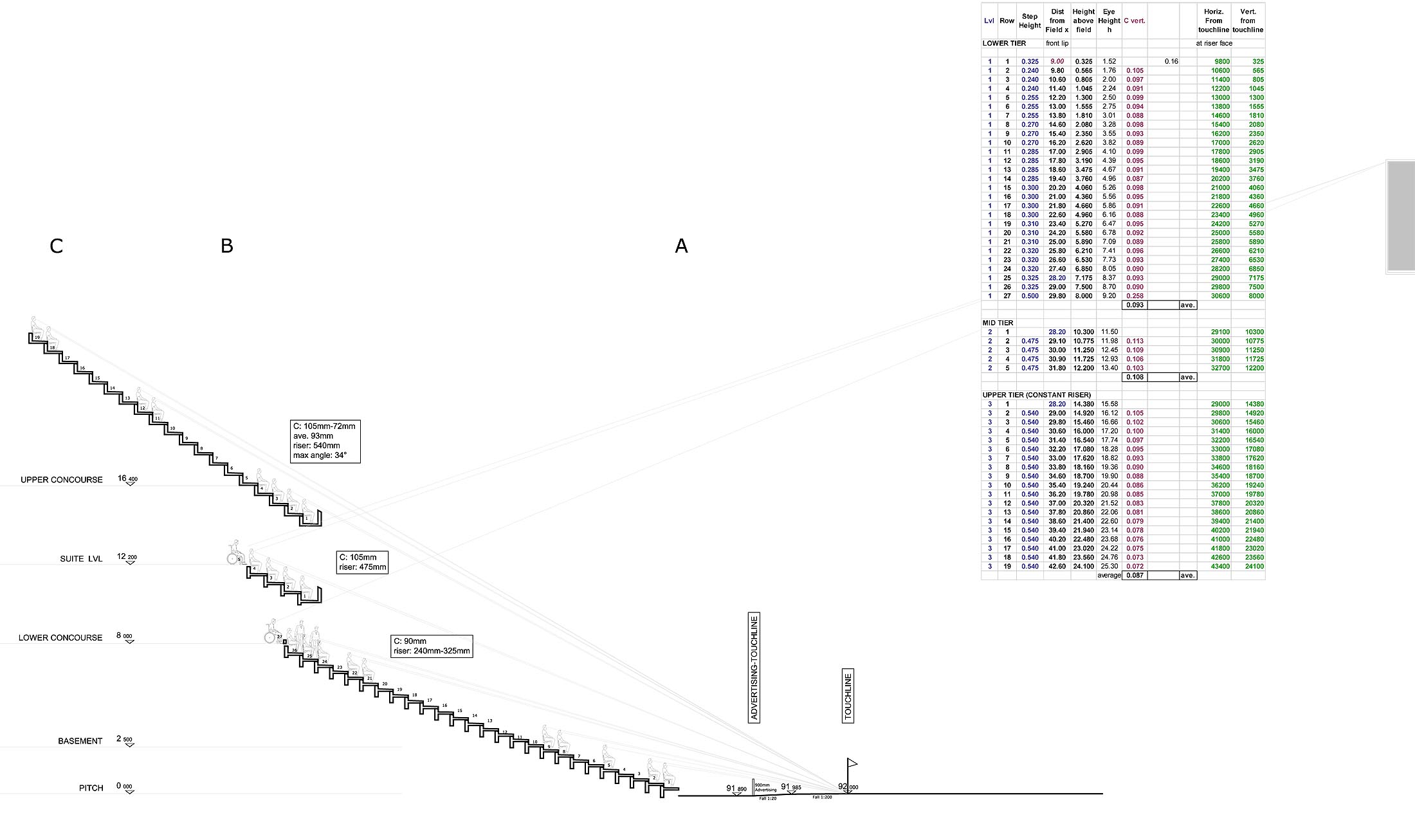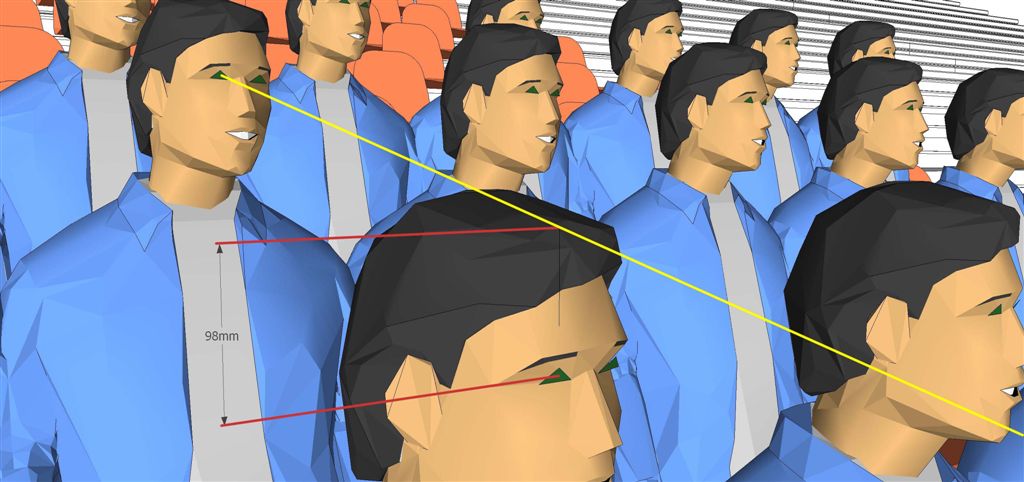|
Visual Axis
In architecture and urban planning, sightlines or vistas are a consideration in the design of civic structures, such as a stage, arena, or monument. They may determine the configuration of architectural elements in theater and stadium design and road junction layout. Many cities such as London and Paris designate visual axes in the layout of streets and squares to allow for views of famous landmarks (terminating vistas). Subjects that have a line of sight with one another are said to be intervisible, where intervisibility is the ability of viewers at separate places to see each other without any landform blocking their view. C-Value Good sightlines allow spectators to see all areas of a venue stage or field of play. To ensure this designers utilize the C-value, defined as the vertical distance from a spectator's eyes to sightline of the spectator directly behind. The C-value is determined in part by the rake, that is, the upward slope of the seating. The stadium bowl rak ... [...More Info...] [...Related Items...] OR: [Wikipedia] [Google] [Baidu] |
Arc De Triomphe Du Carrousel, 16 August 2008
Arc may refer to: Mathematics * Arc (geometry), a segment of a differentiable curve ** Circular arc, a segment of a circle * Arc (topology), a segment of a path * Arc length, the distance between two points along a section of a curve * Arc (projective geometry), a particular type of set of points of a projective plane * arc (function prefix) (arcus), a prefix for inverse trigonometric functions * Directed arc, a directed edge in graph theory * Minute and second of arc, a unit of angular measurement equal to 1/60 of one degree. * Wild arc, a concept from geometric topology Science and technology Geology * Arc, in geology a mountain chain configured as an arc due to a common orogeny along a plate margin or the effect of back-arc extension ** Hellenic arc, the arc of islands positioned over the Hellenic Trench in the Aegean Sea off Greece * Back-arc basin, a subsided region caused by back-arc extension * Back-arc region, the region created by back-arc extension, conta ... [...More Info...] [...Related Items...] OR: [Wikipedia] [Google] [Baidu] |
Landform
A landform is a land feature on the solid surface of the Earth or other planetary body. They may be natural or may be anthropogenic (caused or influenced by human activity). Landforms together make up a given terrain, and their arrangement in the landscape is known as topography. Landforms include hills, mountains, canyons, and valleys, as well as shoreline features such as bays, peninsulas, and seas, including submerged features such as mid-ocean ridges, volcanoes, and the great oceanic basins. Physical characteristics Landforms are categorized by characteristic physical attributes such as elevation, slope, orientation, structure stratification, rock exposure, and soil type. Gross physical features or landforms include intuitive elements such as berms, cliffs, hills, mounds, peninsulas, ridges, rivers, valleys, volcanoes, and numerous other structural and size-scaled (e.g. ponds vs. lakes, hills vs. mountains) elements including various kinds of inland ... [...More Info...] [...Related Items...] OR: [Wikipedia] [Google] [Baidu] |
Stage Terminology
Stage, stages, or staging may refer to: Arts and media Acting * Stage (theatre), a space for the performance of theatrical productions * Theatre, a branch of the performing arts, often referred to as "the stage" * '' The Stage'', a weekly British theatre newspaper * Stages Repertory Theatre, a theatre company in Houston, Texas Music Performers * Stage, an American band featuring Ryan Star Albums * ''Stage'' (David Bowie album), 1978 * ''Stage'' (Great White album), 1995 * ''Stage'' (Keller Williams album), 2004 * ''Stage'', by Mónica Naranjo, 2009 * ''The Stage'' (album), by Avenged Sevenfold, or the title song (see below), 2016 * ''Stages'' (Cassadee Pope album), 2019 * ''Stages'' (Elaine Paige album), 1983 * ''Stages'' (Eric Clapton album), 1993 * ''Stages'' (Jimi Hendrix album), 1991 * ''Stages'' (Josh Groban album), 2015 * ''Stages'' (Melanie C album), 2012 * ''Stages'' (Triumph album), 1985 * ''Stages'' (Vedera album), 2009 * '' Stages: The Lost Album'' ... [...More Info...] [...Related Items...] OR: [Wikipedia] [Google] [Baidu] |
Sightline To Far End Corner Flag
The line of sight, also known as visual axis or sightline (also sight line), is an imaginary line between a viewer/ observer/ spectator's eye(s) and a subject of interest, or their relative direction. The subject may be any definable object taken note of or to be taken note of by the observer, at any distance more than least distance of distinct vision. In optics, refraction of a ray due to use of lenses can cause distortion. Shadows, patterns and movement can also influence line of sight interpretation (as in optical illusions). The term "line" typically presumes that the light by which the observed object is seen travels as a straight ray, which is sometimes not the case as light can take a curved/angulated path when reflected from a mirror, refracted by a lens or density changes in the traversed media, or deflected by a gravitational field. Fields of study feature specific targets, such as vessels in navigation, marker flags or natural features in surveying, celest ... [...More Info...] [...Related Items...] OR: [Wikipedia] [Google] [Baidu] |
Sightlines C-Value
In architecture and urban planning, sightlines or vistas are a consideration in the design of civic structures, such as a stage (theatre), stage, arena, or monument. They may determine the configuration of architectural elements in theater (structure), theater and stadium design and junction (road), road junction layout. Many cities such as London and Paris designate visual axes in the Urban planning, layout of streets and squares to allow for views of famous landmarks (terminating vistas). Subjects that have a line of sight with one another are said to be intervisible, where intervisibility is the ability of viewers at separate places to see each other without any landform blocking their view. C-Value Good sightlines allow spectators to see all areas of a venue stage or field of play. To ensure this designers utilize the C-value, defined as the vertical distance from a spectator's eyes to sightline of the spectator directly behind. The C-value is determined in part by the R ... [...More Info...] [...Related Items...] OR: [Wikipedia] [Google] [Baidu] |
Emery Theatre
The Emery Theatre, or Emery Auditorium, is a historic, acoustically exceptional theater located in the Over-the-Rhine neighborhood of Cincinnati, Ohio. The building was constructed in 1911 as the home for a trade school (the Ohio Mechanics Institute), but its large auditorium was intended for public use. The design of the Emery Theatre is based on the "isacoustic curve" principles that were first proposed by John Scott Russell. The theatre was built with two balconies and a total of 2,211 seats. It was one of the first concert halls in the United States to have no obstructed seats. The Emery was the home of the Cincinnati Symphony Orchestra, who performed there from January 6, 1912 until 1936 when they moved to the larger Music Hall. The quality of acoustics in the Emery Theatre is legendary. The famous conductor Leopold Stokowski compared its acoustics to that of Carnegie Hall in New York City. Many world-renowned performing artists and Broadway stars have appeared a ... [...More Info...] [...Related Items...] OR: [Wikipedia] [Google] [Baidu] |
Auditorium Building
The Auditorium Building is a structure at the northwest corner of South Michigan Avenue (Chicago), Michigan Avenue and Ida B. Wells Drive in the Chicago Loop, Loop community area of Chicago, Illinois, United States. Completed in 1889, it is one of the best-known designs of Louis Sullivan and Dankmar Adler. The building was designed to be a multi-use complex, including offices, a theater, and a hotel. As a young apprentice, Frank Lloyd Wright worked on some of the interior design. The Auditorium Theatre is part of the Auditorium Building and is located at 50 East Ida B. Wells Drive. The theater was the first home of the Chicago Civic Opera and the Chicago Symphony Orchestra. The building was added to the National Register of Historic Places on April 17, 1970. It was declared a National Historic Landmark in 1975, and was designated a Chicago Landmark on September 15, 1976. In addition, it is a historic district contributing property for the Chicago Landmark Historic Michigan B ... [...More Info...] [...Related Items...] OR: [Wikipedia] [Google] [Baidu] |
John Scott Russell
John Scott Russell (9 May 1808, Parkhead, Glasgow – 8 June 1882, Ventnor, Isle of Wight) was a Scottish civil engineer, naval architecture, naval architect and shipbuilder who built ''SS Great Eastern, Great Eastern'' in collaboration with Isambard Kingdom Brunel. He made the discovery of the wave of translation that gave birth to the modern study of solitons, and developed the wave-line system of ship construction. Russell was a promoter of the Great Exhibition of 1851. Early life John Russell was born on the 9th May 1808 with in Parkhead, Glasgow, the son of Reverend David Russell and Agnes Clark Scott. He spent one year at the University of St. Andrews before transferring to the University of Glasgow. It was while at the University of Glasgow that he added his mother's maiden name, Scott, to his own, to become John Scott Russell. He graduated from Glasgow University in 1825 at the age of 17 and moved to Edinburgh where he taught mathematics and science at the Leith Mechani ... [...More Info...] [...Related Items...] OR: [Wikipedia] [Google] [Baidu] |
Alabama Theatre, 1811 Third Avenue North, Birmingham, Jefferson County, AL HABS ALA,37-BIRM,37- (sheet 4 Of 9)
Alabama ( ) is a state in the Southeastern and Deep Southern regions of the United States. It borders Tennessee to the north, Georgia to the east, Florida and the Gulf of Mexico to the south, and Mississippi to the west. Alabama is the 30th largest by area, and the 24th-most populous of the 50 U.S. states. Alabama is nicknamed the '' Yellowhammer State'', after the state bird. Alabama is also known as the "Heart of Dixie" and the "Cotton State". The state has diverse geography, with the north dominated by the mountainous Tennessee Valley and the south by Mobile Bay, a historically significant port. Alabama's capital is Montgomery, and its largest city by population and area is Huntsville. Its oldest city is Mobile, founded by French colonists ( Alabama Creoles) in 1702 as the capital of French Louisiana. Birmingham metropolitan area, Alabama, Greater Birmingham is Alabama's largest metropolitan area and its economic center. Politically, as part of the Deep Sout ... [...More Info...] [...Related Items...] OR: [Wikipedia] [Google] [Baidu] |
Green Guide
The ''Guide to Safety at Sports Grounds'', colloquially known as the ''Green Guide'' is a UK Government-funded guidance book on spectator safety at sports grounds. The Guide provides detailed guidance to ground management, technical specialists such as architects and engineers and all relevant authorities to assist them assess how many spectators can be safely accommodated within a sports ground. It has no statutory force but many of its recommendations will be given force of law at individual grounds by their inclusion in General Safety Certificates issued under the Safety of Sports Grounds Act 1975 or the Fire Safety and Safety of Places of Sports Act 1987. It is written by the Sports Grounds Safety Authority (formally the Football Licensing Authority). Background Following the Ibrox disaster in 1971 when 66 people were killed, the government commissioned a report by Lord Wheatley the following year. In his report Lord Wheatley said: As a result of Lord Wheatley's repor ... [...More Info...] [...Related Items...] OR: [Wikipedia] [Google] [Baidu] |
Rake (theatre)
A rake or raked stage is a stage (theatre), theatre stage that slopes upwards, away from the audience. Such a design was typical of English theatre in the Middle Ages and early Modern era, and improves the view and sound for spectators. It also helps with the illusion of Perspective (graphical), perspective. When features of the scenery are made to align with a notional vanishing point beyond the rear of the stage, the rake supports the illusion. These elements of scenery are termed ''raking pieces''. Raked seating refers to seating which is positioned on an upwards slope away from the stage, in order to give those in the audience at the back a better view than if the seats were all on the same level. Calculating incline The slope of the rake is measured by the number of horizontal units it takes for one vertical unit measured in the direction of the Grade (slope), slope, or by the equivalent percentage. A rake of one horizontal unit to one vertical unit (1 in 1, or a 100% slop ... [...More Info...] [...Related Items...] OR: [Wikipedia] [Google] [Baidu] |





